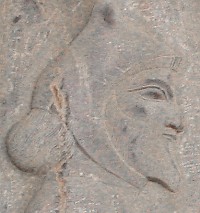The Gherla Inscription
Darius I (Old Persian Dârayavauš): king of ancient Persia, whose reign lasted from 522 to 486. He seized power after killing king Gaumâta, fought a civil war (described in the Behistun inscription), and was finally able to refound the Achaemenid empire, which had been very loosely organized until then. Darius fought several foreign wars, which brought him to India and Thrace. When he died, the Persian empire had reached its largest extent. He was succeeded by his son Xerxes.

One of the most remarkable inscriptions from Antiquity is the following fragmentary text, written in Persian cuneiform script, found in 1937 on a clay tablet in Gherla, and published in 1954:
[...] king [Darius] son of Hystaspes [...]
[...] did [...]
This is of course not a text full of very important information, but the fact that it exists is remarkable, because Gherla is in the northwestern part of modern Romania.
Although this is the only Achaemenid royal inscription that was ever found in Europe, it is not without parallel. The Greek researcher Herodotus of Halicarnassus tells us that Darius, after conquering eastern Thrace (in c.514), visited the source of a river and left the following inscription:
The head-springs of the Tearus give the best and fairest water of all rivers; and to them came (leading an army against the Scythians) the best and fairest of all men, Darius, son of Hystaspes, of the Persians and of all the continent king.note

The first two thirds of this text do not resemble other Achaemenid inscriptions, but the last line and the location of the site remind one of Darius' inscription (DE, especially the last part) near the waters of Gandj Nameh. Although Herodotus renders the contents of the Persian inscription in Thrace erroneously, there are reports that the inscription itself was still visible until 1830.
Back to Gherla. The big question is how this tablet reached Romania. It is unlikely (although not impossible) that the Persian armies crossed the Carpathian mountains. Probably, the tablet was originally placed somewhere in the satrapy of Thrace, and later taken, as booty, to the place where it was excavated.